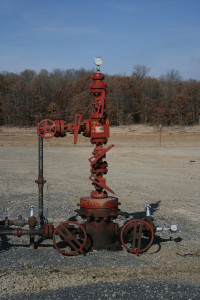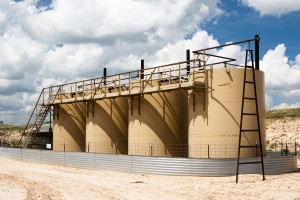Before I continue my series on interpreting royalty statements, I will take the opportunity to give a brief overview of the oil and gas production process. You will find that a basic understanding of the oil and gas production process will greatly improve your ability to interpret a royalty statement.
The oil and gas production process

For the purposes of our discussion, the oil and gas production process begins when oil, gas, and water reach the surface at the wellhead, where they are all mixed together. Before any oil or gas may be sold, this mixture must be separated into its individual components (oil, gas, and water). This separation is generally done at a production battery or production facility. Here the produced fluids are moved through a series of vessels (closed tanks that operate at high pressure) where each component is mechanically separated.
How gas is separated and sold
Generally, the fluid first enters a vessel called a separator where oil and water settle to the bottom and gas rises to the top. Gas exits the top of the separator and is either sent directly to a sales meter or through a scrubber and then to the sales meter. The scrubber is a vessel that has vanes, plates, or mesh that allow the last drops of liquid to be removed from the gas before it is sold. Sometimes, the gas sales pipeline or gathering pipeline operates at a sufficiently high pressure requiring natural gas from the separator to be compressed before it can be sold.
After the gas is sold, it flows through a gathering system to a processing or treatment plant where a number of processes occur. Here gas is treated to remove impurities such as oxygen, carbon dioxide, and hydrogen sulfide; it is dehydrated to remove water vapor, and it is cryogenically processed to remove sellable products such as propane and butane.
How oil and water are separated
The mixture of oil and water from the bottom of the separator flows to a vessel called a free-water knockout. In this vessel, because oil is less dense than water, the two fluids begin to separate as oil rises to the top of the water. The oil flows over the top of a weir (similar to a dam inside the vessel) while most of the water stays behind the weir. Water from the free-water knockout is sent to stock tanks to be trucked or pumped to a disposal facility.
After the oil (with some water) flows over the weir in the free-water knockout it is sent to another vessel called a heater treater. The heater treater has a heating element, called a fire tube, which uses produced natural gas (i.e. from the separator) as fuel. The fire tube heats the oil causing any remaining water to settle to the bottom of the treater where it can be sent to storage tanks. Oil from the top of the heater treater is finally sent to stock tanks where it is held until it can be sold. Technically, oil is sold either at the load lines where it is loaded onto trucks or at a LACT (lease automatic custody transfer) meter where it enters a sales pipeline.

In colder climates such as Montana, North Dakota, or Wyoming, the oil and water tanks must be heated to prevent them from freezing. This is done by using produced natural gas (i.e. form the separator) to heat fluid that circulates through lines on the outside of production tanks.
